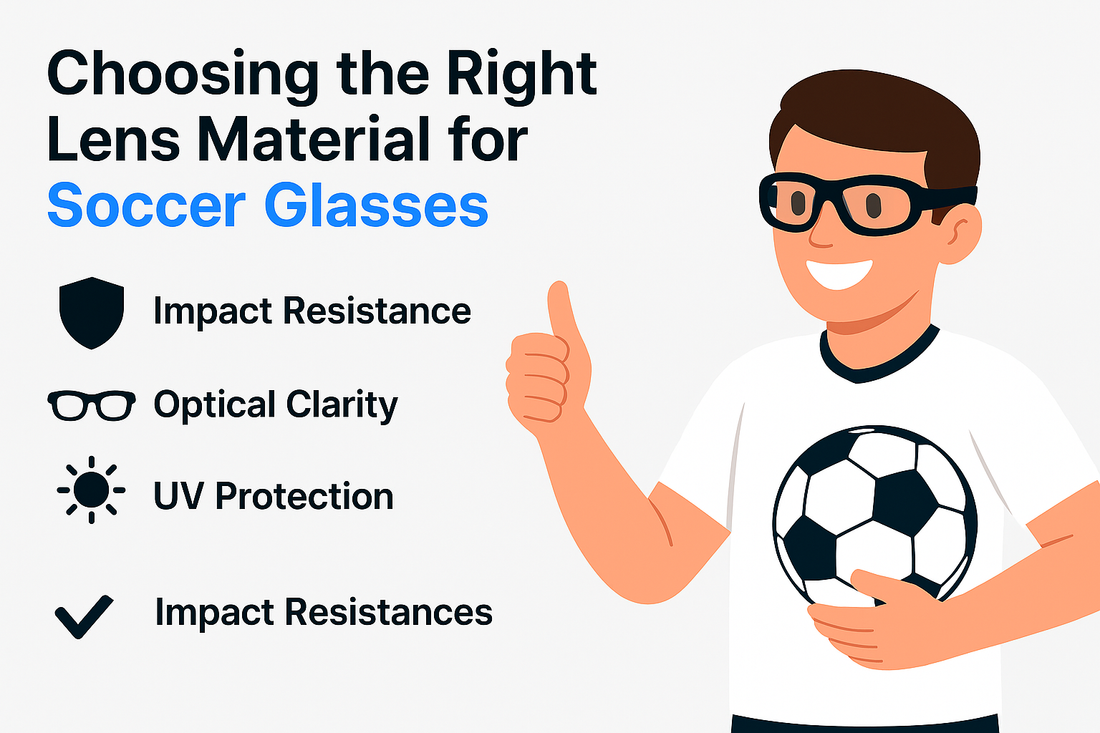
Choosing the Right Lens Material for Soccer Glasses
Fast sprints, sudden turns, flying elbows, and bright sun are a normal day on the pitch. If you wear soccer glasses, your lens material is the unsung hero behind clear vision and reliable protection. Pick the right lenses and you get sharp optics, lightweight comfort, and serious impact resistance. Pick wrong and you risk fog, glare, distortion, or worse. Here is how to choose lenses that keep up with your game. ⚽
What soccer demands from your lenses
Soccer is a high-speed, high-contact sport, so your lenses should check five boxes: impact resistance, optical clarity, light weight, UV protection, and anti-fog performance. Add scratch resistance for longevity, and you have a winning checklist.
Lens materials compared
Polycarbonate: the go-to for most players 🛡️
Why it works: Polycarbonate offers outstanding impact resistance, built-in 100% UV protection, and a lightweight feel that stays comfortable through extra time. It is typically the best value choice for soccer glasses.
Keep in mind: Optical clarity is very good, though a notch below Trivex. Because the surface is softer, make sure you add a quality hard coat to boost scratch resistance.
Trivex: crisp optics with trusted protection
Why it works: Trivex delivers impact protection on par with polycarbonate, but with slightly crisper optics and very low weight. It is also great for drill-mount or semi-rimless sport frames because it holds screws well.
Keep in mind: It generally costs more than polycarbonate and can have fewer ultra-thin options. If you prioritize visual clarity and comfort, it is an excellent choice.
High-index plastic: for strong prescriptions
Why it works: If you have a high prescription and want slimmer lenses, high-index plastic can reduce thickness and edge weight.
Keep in mind: High-index lenses are typically less impact resistant than polycarbonate or Trivex. For aggressive play or frequent headers, most players are better served by polycarbonate or Trivex. Another route is contact lenses paired with plano polycarbonate sports lenses.
Treatments that boost performance
Anti-fog coating: Keeps lenses clear during intense efforts, humid weather, or when wearing a face covering. A must-have for uninterrupted vision.
Hard coat (scratch resistance): Polycarbonate and Trivex benefit from a premium hard coat to handle turf dust, sweat, and frequent cleaning.
Anti-reflective (AR): Reduces reflections from stadium lights and afternoon sun, improving contrast and ball tracking.
UV protection: Built into polycarbonate and Trivex. Make sure any high-index lens also provides full UV coverage.
Tints and photochromic: Grey or brown tints help in bright daylight. Photochromic lenses adapt as conditions change from cloudy to sunny 🌤️ and are convenient if your matches stretch across different light levels.
Polarized: Great for water or snow, but can sometimes flatten contrast on turf and affect depth perception. Many soccer players skip polarization and rely on AR plus a light tint or photochromic instead.
Match your lenses to your play
All-around field players: Polycarbonate with hard coat, AR, and anti-fog is the workhorse setup for clarity and protection.
Players who want the sharpest optics: Trivex with premium AR and anti-fog offers crisp vision and comfort for long sessions.
High prescriptions: Consider high-index only if impact needs are lower. Otherwise, contacts with plano polycarbonate lenses or Trivex can be a safer plan.
Indoor vs outdoor considerations
Outdoor daytime: Light grey or brown tint, or photochromic with AR, helps with glare while preserving natural color. Mirror coatings can add extra glare control and style. 😎
Night or indoor play: Clear lenses with AR and anti-fog maximize light transmission and reduce haloing from LEDs.
Care tips that extend lens life
Rinse lenses with cool water after dusty practices, then clean with lens spray and a microfiber cloth. Store in a rigid case. Avoid paper towels and shirt hems, which can grind grit into the surface.
FAQs.
How do I choose between polycarbonate and Trivex?
Pick polycarbonate for best value and robust impact protection. Choose Trivex if you want slightly crisper optics and ultra-light comfort.
What lens coating matters most for soccer?
Anti-fog is key, followed by a quality hard coat and anti-reflective treatment for glare control.
Can I use polarized lenses for soccer?
You can, but many players prefer non-polarized with AR to maintain contrast and depth cues on turf.
Do photochromic lenses work for evening matches?
Yes, they adjust with light. For night games, choose clear lenses with AR for maximum brightness.
Why avoid standard plastic lenses?
CR-39 is more brittle and heavier, offering less impact protection than polycarbonate or Trivex, which are better for the pitch.



